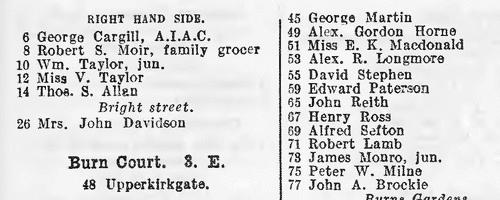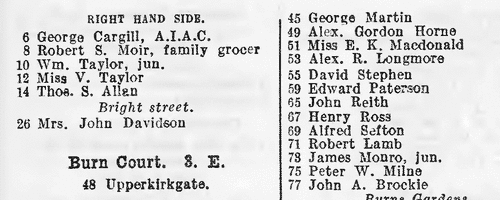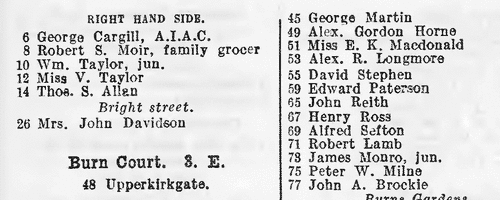Add this eBook to your basket to receive access to all 333 records. Our indexes include entries for the spelling cruickshank. In the period you have requested, we have the following 333 records (displaying 271 to 280): These sample scans are from the original record. You will get scans of the full pages or articles where the surname you searched for has been found. Your web browser may prevent the sample windows from opening; in this case please change your browser settings to allow pop-up windows from this site. Boys entering Gresham's School
(1939)
The Sir John Gresham Grammar School at Holt in Norfolk was founded by sir John, who bought the manor house there in 1546 to convert it into a school, and building work had started by 1555. To celebrate the quatercentenary in 1955, a history of the school written by the Reverend C. L. S. Linnell was published, together with an Alumni Greshamienses, a register of boys entering the school from 1562 to 1954, compiled by A. B. Douglas. The materials to hand for the register for the early years were slight; the first coherent lists of boys survive only from 1729, and then are fitful, with little detail, and largely missing from 1784 to 1803; however, from 1810 onwards the names of boys' parents are usually recorded. The register is arranged chronologically by year (and from 1900 by term - L, Lent; M, Michaelmas; S, Summer), and then alphabetically by surname (in capitals) and christian name(s). Where known, year of birth is then given (in brackets), names, addresses and occupations of parents. From 1900 onwards there are italic abbreviations for sporting achievements at school (h, hockey colours; VIII, shooting colours; S, first-class swimmer; XI, cricket colours; XV, football colours), and p for house prefect and P for school prefect; then (in italics) information about the boy's adult life, and his address (where living) at the time of publication. Finally, on the right hand side of the page, in italics, is given the year of his leaving the school. Most detail is absent before 1810; and, of course, for the boys still at school in 1955, or only recently left, there are no details of future career; nor are there the usual details about their parentage. From 1898 onwards day boys are noted with an italic D (N means Newquay dayboy); and from 1900 onwards the school houses are shown (B, Bengal Lodge; F, Farfield; H, School House or Howson's; K, Kenwyn; O, Old School House; W, Woodlands); and, for the junior school, c, Crossways; k, Kenwyn; o, Old School House). | Sample scan, click to enlarge

| Chartered Electrical Engineers (M. I. E. E.)
(1939)
The Institution of Electrical Engineers was founded in 1871 under the name of The Society of Telegraph Engineers, and incorporated by royal charter in 1921. The list of members, corrected to 1 September 1939, gives the names and addresses of the various grades of members. Members (M. I. E. E.) and Associate Members (A. M. I. E. E.) were entitled to describe themselves as Chartered Electrical Engineers. Then there are the Associates (Associate I. E. E.), Companions (Companion I. E. E.), Graduates (Graduate I. E. E.) and Students (Student I. E. E.). The names are given in bold, surname first; before each name is the year of attaining that grade; and for the higher grades the year of each lower grade is also given, e. g. (G. 1931). | Sample scan, click to enlarge

| Residents of Aberdeen: Anderson Drive (1939)
The street directory gives full names (christian and surname, or initials and surname) street by street and house by house (house name or number), specifying where the street starts, and where and on which side of the road each house stood. In the case of longer streets the position of an individual house can be located because the names of intersecting streets are given in italics, and fixed points such as post offices and churches are also indicated.
| Sample scan, click to enlarge

| Residents of Aberdeen: Anderson Drive South (1939)
The street directory gives full names (christian and surname, or initials and surname) street by street and house by house (house name or number), specifying where the street starts, and where and on which side of the road each house stood. In the case of longer streets the position of an individual house can be located because the names of intersecting streets are given in italics, and fixed points such as post offices and churches are also indicated.
| Sample scan, click to enlarge

| Residents of Aberdeen: Annfield Terrace (1939)
The street directory gives full names (christian and surname, or initials and surname) street by street and house by house (house name or number), specifying where the street starts, and where and on which side of the road each house stood. In the case of longer streets the position of an individual house can be located because the names of intersecting streets are given in italics, and fixed points such as post offices and churches are also indicated.
| Sample scan, click to enlarge

| Residents of Aberdeen: Ashley Gardens (1939)
The street directory gives full names (christian and surname, or initials and surname) street by street and house by house (house name or number), specifying where the street starts, and where and on which side of the road each house stood. In the case of longer streets the position of an individual house can be located because the names of intersecting streets are given in italics, and fixed points such as post offices and churches are also indicated.
| Sample scan, click to enlarge

| Residents of Aberdeen: Ashley Road (1939)
The street directory gives full names (christian and surname, or initials and surname) street by street and house by house (house name or number), specifying where the street starts, and where and on which side of the road each house stood. In the case of longer streets the position of an individual house can be located because the names of intersecting streets are given in italics, and fixed points such as post offices and churches are also indicated.
| Sample scan, click to enlarge

| Residents of Aberdeen: Balmoral Place (1939)
The street directory gives full names (christian and surname, or initials and surname) street by street and house by house (house name or number), specifying where the street starts, and where and on which side of the road each house stood. In the case of longer streets the position of an individual house can be located because the names of intersecting streets are given in italics, and fixed points such as post offices and churches are also indicated.
| Sample scan, click to enlarge

| Residents of Aberdeen: Beaconsfield Place (1939)
The street directory gives full names (christian and surname, or initials and surname) street by street and house by house (house name or number), specifying where the street starts, and where and on which side of the road each house stood. In the case of longer streets the position of an individual house can be located because the names of intersecting streets are given in italics, and fixed points such as post offices and churches are also indicated.
| Sample scan, click to enlarge

| Residents of Aberdeen: Beechgrove Terrace (1939)
The street directory gives full names (christian and surname, or initials and surname) street by street and house by house (house name or number), specifying where the street starts, and where and on which side of the road each house stood. In the case of longer streets the position of an individual house can be located because the names of intersecting streets are given in italics, and fixed points such as post offices and churches are also indicated.
| Sample scan, click to enlarge

|
Research your ancestry, family history, genealogy and one-name study by direct access to original records and archives indexed by surname.
|











